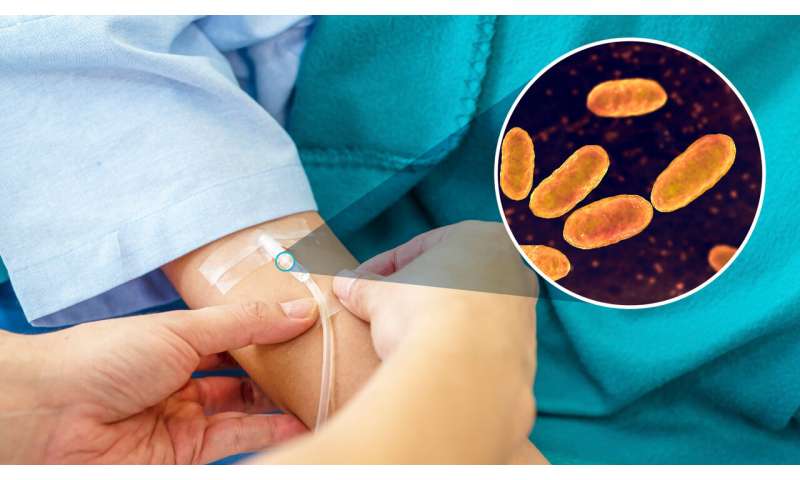Researchers aim to reduce catheter-related infections with wearable sensor

Hospitalized patients have enough to worry about without adding an unexpected infection to the list. Unfortunately, each year, about 250,000 hospitalized patients in the U.S. develop a catheter-related bloodstream infection, which can be life-threatening, extend their hospital stay and increase costs associated with their recovery.
A catheter-related bloodstream infection most often occurs when a patient needs a central venous catheter, also called a central line. These central venous catheters are inserted into one of the large veins with a direct path to the heart. They are typically required for critically ill patients and serve multiple purposes, including rapid medication delivery or heart function monitoring.
Dr. Hatice Ceylan Koydemir, an assistant professor in the Department of Biomedical Engineering at Texas A&M University and faculty researcher at the Texas A&M Engineering Experiment Station's Center for Remote Health Technologies & Systems, aims to address this problem with new technology. Koydemir and her team are developing a catheter dressing that may ultimately help reduce the number and severity of catheter-related bloodstream infections. The dressing will be part of the catheter and include wireless sensors to detect very low concentrations of bacterial growth on the skin. Koydemir was recently awarded a grant from the National Institutes of Health to fund her research.
"This is one of my dream projects," Koydemir said because of the widespread impact this research could have by reducing these deadly infections.
No existing catheter can automatically and promptly detect bacterial growth at the catheter-insertion site. Other researchers have attempted to indirectly detect the presence of bacteria through other biomarkers like changes in the skin's pH. Koydemir's research takes a different approach.
"We are aiming to do a direct detection of the bacteria," she said.
If their project is successful, the wearable sensors in the catheter dressing will alert medical providers about bacterial growth without requiring them to remove the dressing first.
Currently, medical providers must wait for signs or symptoms of infection, such as a fever, chills or swelling and drainage at the insertion site. Signs like swelling or drainage may be missed initially because the dressing obscures them. Delays in spotting an infection could leave time for the infection to worsen.
"I thought there should be a way to detect infection much earlier," Koydemir said.
For comparison, in wound-care research, scientists work with between a million and a billion colony-forming units (CFU) of bacteria per milliliter. A CFU is an estimate of the number of bacteria in a sample that are alive and capable of multiplying into a new colony. Koydemir is hoping to detect bacteria at concentrations of only 100 CFU per milliliter.
Once an infection is suspected, medical providers must wait for the blood test results to confirm an infection is present. They may decide to administer antibiotics while waiting for the test results, but providers cannot prescribe a targeted antibiotic without knowing which bacteria are present. Overuse of antibiotics that target a wide range of bacteria, including bacteria that are helpful to the body, contributes to the formation of antibiotic-resistant bacteria.
Koydemir hopes this project will lead to early detection of bacterial growth and, eventually, tailored antibiotic therapy specific to the growing bacteria. Tailored antibiotic therapy could reduce antibiotic resistance. However, she is anticipating some challenges in her research.
"It will be difficult to detect very, very low concentrations of bacterial growth, especially when people have varying skin chemistries that can change throughout the day due to sweat, for example," she said. "We are trying to push the limits to detect fewer bacteria," Koydemir said.
Other challenges include making the dressing flexible, incorporating a long-lasting adhesive and using material that won't trigger allergies in patients.
Dr. Levent Beker, an assistant professor in the Department of Mechanical Engineering at Koç University in Istanbul, Turkey, is an external collaborator on this project.
More information:
reporter.nih.gov/search/xS1qew … ect-details/10647072
Provided by Texas A&M University College of Engineering